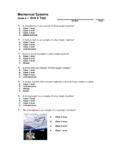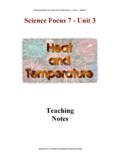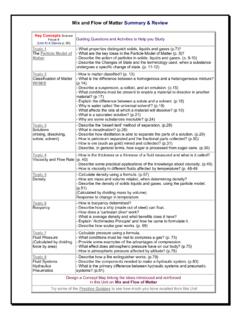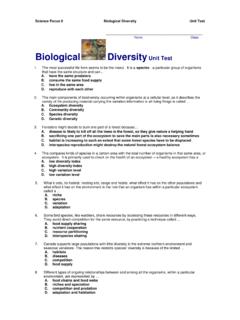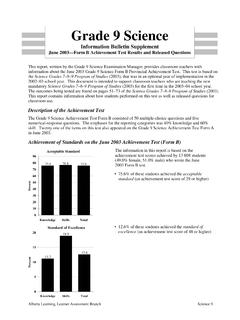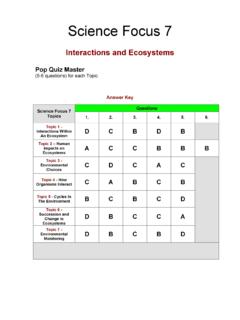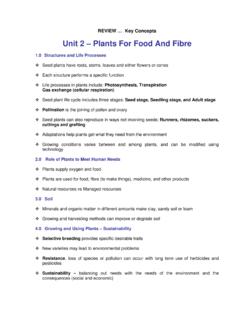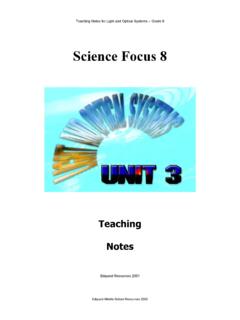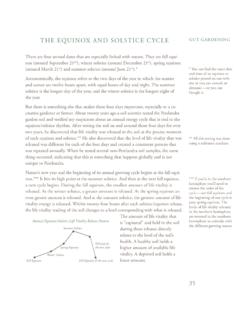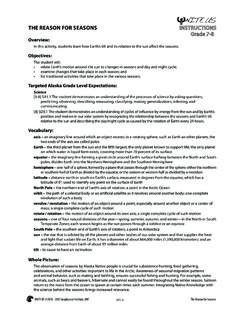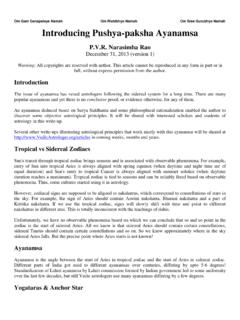Transcription of Science Focus 9 Space Exploration Topic Test
1 Science Focus 9 Space Exploration Topic Test Space Exploration UNIT TEST ASSESSMENT _____ _____. Student Name Class 1. The axis for the frame of reference to identify locations on the earth are . A. equinox and solstice B. Ecuador and Madagascar C. Equator and Prime Meridian D. Tropics of Cancer and Capricorn 2. The Ancient Egyptians believed that the Sun God Ra was pulled across the sky in a sacred . A. sled B. boat C. wagon D. chariot 3. The astrolabe is a device that is used to measure azimuth. It was invented by . A. Aristotle B. Galileo Galilei C. Ancient Greeks D. Ancient Egyptians 4. The stars are used as a frame of reference to the track the actual motion of each celestial body, because the motions we look at in the sky are different from the big motion caused by the Earth's.
2 A. rotation B. altitude C. azimuth D. orbit 5. Ptolemy and Copernicus each developed a model of celestial bodies in our universe that explained the epicycles' of the planets. The biggest difference between their representations was that . A. Ptolemy had the sun at the centre B. Copernicus had the sun at the centre C. Ptolemy had the Earth revolving around the Sun D. Copernicus had the Sun revolving around the Earth 6. A navigation device that ancient people used to measure altitude of stars in the night sky was the . A. sextant B. astrolabe C. quadrant D. compass 7. Galileo's telescopic observations of the moons orbiting Jupiter, supported.
3 A. Copernicus's Sun-centered model B. Ptolemy's Earth-centered model C. Kepler's Earth-centred model D. Pythagorus' Sun-centred model 8. In order to get finer detail in a telescopic image, the telescope must improve it's . A. ocular power B. resolving power C. telescopic power D. reflective power 9. The Hubble Space Telescope is a cylindrical reflecting telescope, 13 m long and m in diameter. Because parts of this telescope can be removed and replaced it is considered to be . A. functional B. modular C. flexible D. mobile 10. Kepler solved the problem of the epicycles by insisted that the orbits of the planets should be.
4 A. elliptical B. epicylcled C. circular D. semi-circular Science Focus 9 Space Exploration Topic Test 11. A device enabling you to pass light through a narrow slit before sending it through a prism is called a . A. spectroscope B. spectrograph C. spectrogram D. spectrometer 12. With thousands of closely spaced slits much better detail in the spectrum can be produced using this device . A. deflector dish B. reflective grid C. refracting prism D. diffraction grating 13. The spectrum of an approaching star shows the dark bands shift to the A. blue end of the spectrum B. center of the spectrum C. violet part of the spectrum D.
5 Red part of the spectrum 14. The spectrum that produces dark lines when white light passes through a cooler substance is called . A. emmission B. continuous C. absorption D. defraction 15. The spectroscope's application to astronomy has helped astronomers determine the . A. orbital rotation B. distance of stars C. composition of stars D. life cycle of a star 16. The NTT (New Technology Telescope) directs computers to control an image, always moving the mirror to reflect changes in the Earth's atmosphere. The technology that does this is called . A. fibre optics B. adaptive optics C. reflective optics D.
6 Spectral optics 17. The twinkling effect of a star is created by the . A. atmospheric motion B. debris in Space C. size of the star D. composition of the star 18. Two ways to measure long distances indirectly, on the ground, or in Space are triangulation and . A. spectroscopy B. holography C. diffraction D. parallax 19. Using the parallax technique, the longest baseline that astronomers can use is the diameter of Earth's . A. orbit B. crust C. surface D. atmosphere 20. Triangulation is based on a process of estimation, using these 3 steps: 1. Making a scale drawing 2. Creating a baseline 3. Measuring angles from the end of the baseline The correct order of the steps to follow in this method of estimating distance is.
7 A. 1 2 3. B. 2 3 1. C. 2 1 3. D. 3 2 1. Science Focus 9 Space Exploration Topic Test 21. One part of the electromagnetic spectrum is gamma waves. Their waves are known by their . A. low frequency and long wavelengths B. low frequency and short wavelengths C. high frequency and long wavelengths D. high frequency and short wavelengths 22. Radio telescope waves provide data, which astronomers graph, using computers to store the data and false color it to produce images of the radio waves, which are coded to the strength of the waves. For low intensity waves, they are colored . A. red B. blue C. green D. yellow 23.
8 The greater the distance between the radio telescopes the more accurately they can measure . A. size B. distance C. position D. composition 24. To improve accuracy many radio telescopes are combined electronically. This collection of many radio telescopes is called . A. a farm B. an array C. an order D. a grouping 25. Additional resolution in a VLA image identified a central white region in a galaxy in deep Space which astronomers think is the location of a . A. new star B. bying star C. black hole D. active galaxy 26. The Science of rocketry relies on a basic physics principle: For every action . A. Forces will remain constant B.
9 There is an equal and opposite reaction C. Distance and speed will be decreased D. There is a reason to overcome gravity 27. All fuels create exhaust which comes out the end of the rocket. The speed of the exhaust leaving the rocket is called the exhaust velocity, which determines the.. A. speed of the rocket B. range of the rocket C. direction of the rocket D. altitude of the rocket 28. A bomb that is powered by a rocket engine like the V-2 rocket is called a . A. hydrogen bomber B. atomic reaction C. ballistic missile D. scuba missile 29. A method of acceleration which enables a spacecraft to achieve extra speed by using the gravity of a planet is called.
10 A. elliptical acceleration B. gravitational assist C. momentum acceleration D. orbital velocity 30. Satellites can be natural or artificial the only natrural satellites in this list . A. Moon B. Anik 1. C. LANDSAT. D. RADARSAT. Science Focus 9 Space Exploration Topic Test 31. The Sun's energy is charged particles released in all directions. This solar wind bombards the Earth at 400km/s, but this protects us . A. The Asteroid Belt B. Earth's magnetic field C. Earth's atmosphere D. Axis and rotation of the Earth 32. The formation of our solar system is based on the . A. Big bang theory B. Theory of relativity C.
